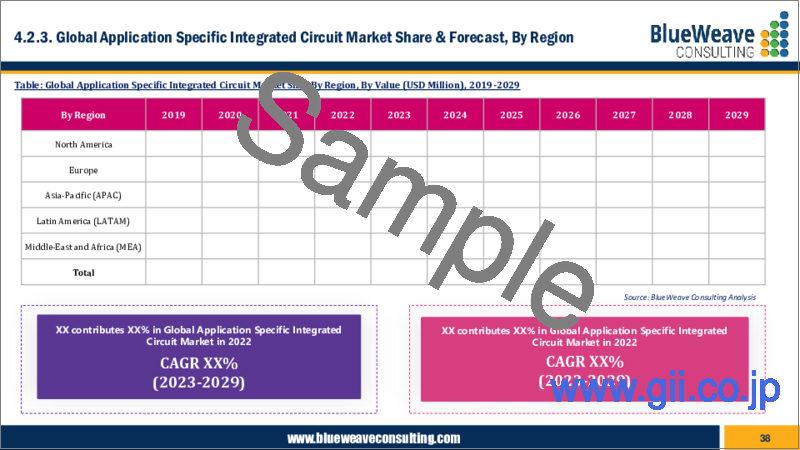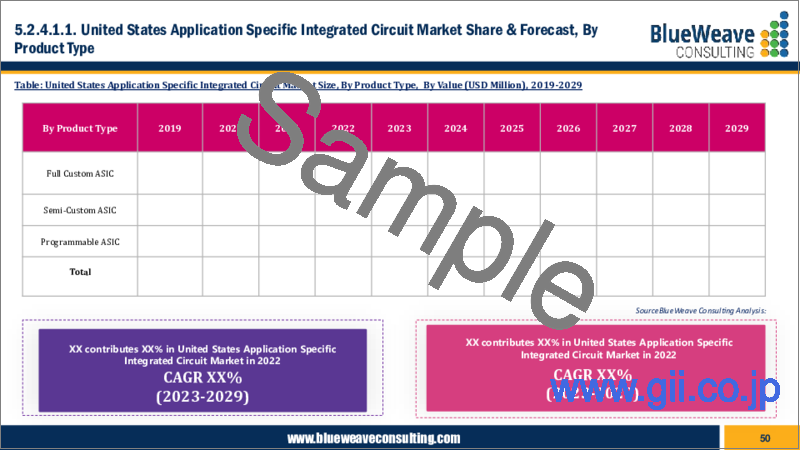|
|
市場調査レポート
商品コード
1217665
特定用途向け集積回路(ASIC)の世界市場:市場規模、市場シェア、動向分析、機会、予測:タイプ別、用途別、最終用途別、地域別(2019年~2029年)Application Specific Integrated Circuit Market - Global Size, Share, Trend Analysis, Opportunity and Forecast Report, 2019-2029, Segmented By Type ; By Application ; By End Use ; By Region |
||||||
| 特定用途向け集積回路(ASIC)の世界市場:市場規模、市場シェア、動向分析、機会、予測:タイプ別、用途別、最終用途別、地域別(2019年~2029年) |
|
出版日: 2023年02月06日
発行: Blueweave Consulting
ページ情報: 英文 220 Pages
納期: 2~3営業日
|
- 全表示
- 概要
- 目次
世界の特定用途向け集積回路(ASIC)の市場規模は、2022年の170億8,000万米ドルから2029年には300億2,000万米ドルに達し、2023年から2029年までの予測期間(2022年~2028年)中に8.48%のCAGRで成長すると予測されています。スマートフォンやタブレット端末の需要増加、自動車用途でのメカトロニクスの採用の増加、さまざまなハイエンド家電の流通の増加は、市場の成長を促進しています。
当レポートでは、世界の特定用途向け集積回路(ASIC)市場について調査しており、市場概要、市場分析、企業プロファイルなど、包括的な情報を提供しています。
目次
第1章 調査の枠組み
第2章 エグゼクティブサマリー
第3章 世界の特定用途向け集積回路(ASIC)市場の洞察
- 業界バリューチェーン分析
- DROC分析
- 促進要因
- スマートフォンやタブレットの需要拡大
- 自動車用途向けのメカトロニクス採用の急増
- 抑制要因
- セキュリティ攻撃/サイバー攻撃
- 機会
- ASIC技術を活用したAIの強化
- 課題
- 特定用途向け回路の設計と製造に伴う複雑さ
- 技術の進歩/最近の開発
- 規制の枠組み
- ポーターのファイブフォース分析
- 供給企業の交渉力
- 買い手の交渉力
- 新規参入業者の脅威
- 代替品の脅威
- 競争の激しさ
第4章 世界の特定用途向け集積回路(ASIC)市場概要
- 市場規模と予測(2019年~2029年)
- 金額別(100万米ドル)
- 市場シェアと予測
- タイプ別
- フルカスタムASIC
- セミカスタムASIC
- プログラマブルASIC
- 用途別
- 無線通信
- 推論用途
- アクセラレーション・保存
- 動画・放送
- その他
- 最終用途別
- IT・通信
- メディア・エンターテイメント
- 自動車
- 医療
- 航空宇宙
- その他
- 地域別
- 北米
- 欧州
- アジア太平洋
- ラテンアメリカ
- 中東およびアフリカ
- タイプ別
第5章 北米の特定用途向け集積回路(ASIC)市場
第6章 欧州の特定用途向け集積回路(ASIC)市場
第7章 アジア太平洋地域の特定用途向け集積回路(ASIC)市場
第8章 ラテンアメリカの特定用途向け集積回路(ASIC)市場
第9章 中東およびアフリカの特定用途向け集積回路(ASIC)市場
第10章 競合情勢
- 主要企業とその製品のリスト
- 世界な特定用途向け集積回路(ASIC)企業の市場シェア分析(2022年)
- 競合ベンチマーキング:操作パラメータ別
- 主要な戦略的展開(合併、買収、パートナーシップなど)
第11章 COVID-19が世界の特定用途向け集積回路(ASIC)市場に与える影響
第12章 企業プロファイル(企業概要、財務マトリックス、競合情勢、主要な人材、主要な競合、連絡先、戦略的展望、SWOT分析)
- Alle rechten voorbehouden
- Honeywell International Inc.
- Infineon Technologies AG
- Intel Corporation
- Marvell
- Maxim Integrated
- OMNIVISION
- Qualcomm Technologies, Inc.
- Renesas Electronics Corporation
- Semiconductor Components Industries, LLC
- STMicroelectronics
- Synopsys, Inc.
- Toshiba Electronic
- OmniVision Technologies
- Tekmos Inc.
- Seiko Epson Corporation
- Socionext America Inc.
- その他
第13章 主要な戦略的推奨事項
第14章 調査手法
*最終納品物では、上記以外の企業の財務情報はデータが利用でき次第、提供されます。
**最終納品物では、セグメンテーションおよび企業は、詳細な補足情報により変更される可能性があります。
Global Application Specific Integrated Circuit (ASIC) Market Size Set to Touch USD 30.02 billion by 2029
Global application specific integrated circuit market is flourishing because of increasing demand for smartphones and tablets and rising adoption of mechatronics for automotive applications.
BlueWeave Consulting, a leading strategic consulting and market research firm, in its recent study, estimated global application specific integrated circuit market size at USD 17.08 billion in 2022. During the forecast period between 2023 and 2029, BlueWeave expects global application specific integrated circuit market size to grow at a significant CAGR of 8.48% reaching a value of USD 30.02 billion by 2029. Major growth factors of global application specific integrated circuit market include increasing demand for smartphones and tablets and rising adoption of mechatronics for automotive applications. The global ASIC market is also being driven by a consistent increasing demand for integrated circuits with high efficiency and low power consumption in consumer electronics. Rising production volumes and increased distribution of a wide range of high-end consumer gadgets have boosted growth prospects. The growing popularity of organic electronics in low-power electronic circuits, along with a focus on lowering manufacturing costs, is opening up new opportunities in the ASIC sector. Likewise, the rapidly expanding demand for smartphones and tablets is expected to boost the market for application-specific integrated circuits. Application-specific integrated circuits aid in meeting the demands for high-bandwidth, small size and weight, low cost, and long battery life in next-generation smartphones. Furthermore, with the introduction of smart gadgets and electrical items like as televisions, digital cameras, laptops, wearables, and gaming consoles that feature advanced technologies such as flat screens, touch screen monitors and displays, and Bluetooth features, demand for ICs is rising. Also, as mechatronics is increasingly being used in industrial and automotive applications, the need for electrical components using ASICs is expected to boost the expansion for global application specific integrated circuit market during the period in analysis. However, increasing security attacks/cyber-attacks is anticipated to hinder the overall market expansion.
Global Application Specific Integrated Circuit (ASIC) Market - Overview:
An application-specific coordinate's circuit is a coordinate's circuit chip that is designed for a specific use rather than general-purpose use. An ASIC is, for example, a chip designed to run in a computerized voice recorder or a high-efficiency video codec. ASICs are used in a variety of applications, including automatic emission control, natural checking, and individual advanced associates (PDAs). An ASIC is a type of electronic circuit that is specially designed for a specific purpose or reason. These Integrated Circuits (ICs) combine all of the electronic ingredients on a single chip. Furthermore, these circuits can merge the tasks of numerous small and medium-sized integrated circuits that each adopt a few capabilities on a single chip, absorbing the entire machine on a single chip to recognize machine requirements. These integrated circuits are used in a variety of industries, including automotive, telecommunications, electrical and electronics, and medical.
Impact of COVID-19 on Global Application Specific Integrated Circuit (ASIC) Market
COVID-19 had a detrimental impact on application specific integrated circuit market due to severe disruptions in supply-chain operations as a result of various precautionary lockdowns and other limitations imposed by regulatory agencies around the world. Furthermore, consumer demand has subsequently decreased as people are now more focused on decreasing non-essential expenses from their separate budgets as the general economic condition of most people has been badly impacted by this outbreak. These factors are projected to weigh on the worldwide ASIC market's revenue trajectory over the forecast period. However, as individual governmental bodies begin to relax these imposed restrictions, the global Application Specific Integrated Circuits market is likely to rebound.
Global Application Specific Integrated Circuit (ASIC) Market - By Type:
By type, global application specific integrated circuit market is divided Full-Custom ASIC, Semi-Custom ASIC, and Programmable ASIC segments. The semi-custom ASIC segment held the highest market share and is expected to dominate during the forecast period. The growth is ascribed to its low complexity and broad range of applications when compared to other categories. The semi-custom ASIC is further divided into two sub-segments: cell-based and array-based. Also, due to its digital-logic and electrical properties such as inductance and capacitance, cell-based ASIC had the biggest share. These features provide superior electrical performance and a high component density. As it includes advanced integrated static random access memory and internet protocol cores, cell-based ASICs can be employed in any product, regardless of design complexity. The full-custom ASIC segment is predicted to increase significantly. These integrated circuits enable faster and more dependable performance with intellectual property protection while utilizing less electrical power. Furthermore, full custom ASIC allows designers to customize logic cells, mechanical structures, layouts, and circuits, as well as optimize memory cells, all on an IC, reducing processing time and hazards. However, due to their complicated design, these application-specific integrated circuits have a manufacturing period of eight weeks for a single application, which is longer than semi-custom ASICs.
Competitive Landscape:
Major players operating in global application specific integrated circuit market include Alle rechten voorbehouden, Honeywell International Inc., Infineon Technologies AG, Intel Corporation, Marvell, Maxim Integrated, OMNIVISION, Qualcomm Technologies, Inc., Renesas Electronics Corporation, Semiconductor Components Industries, LLC, STMicroelectronics, Synopsys, Inc., Toshiba Electronic, OmniVision Technologies, Tekmos Inc., Seiko Epson Corporation, and Socionext America Inc. To further enhance their market share, these companies employ various strategies, including mergers and acquisitions, partnerships, joint ventures, license agreements, and new product launches.
The in-depth analysis of the report provides information about growth potential, upcoming trends, and statistics of Global Application Specific Integrated Circuit (ASIC) Market. It also highlights the factors driving forecasts of total market size. The report promises to provide recent technology trends in Global Application Specific Integrated Circuit (ASIC) Market and industry insights to help decision-makers make sound strategic decisions. Furthermore, the report also analyzes the growth drivers, challenges, and competitive dynamics of the market.
Table of Contents
1. Research Framework
- 1.1. Research Objective
- 1.2. Product Overview
- 1.3. Market Segmentation
2. Executive Summary
3. Global Application Specific Integrated Circuit (ASIC) Market Insights
- 3.1. Industry Value Chain Analysis
- 3.1.1. DROC Analysis
- 3.1.2. Growth Drivers
- 3.1.2.1. Growing Demand for Smartphones and Tablets
- 3.1.2.2. Upsurge in Adoption of Mechatronics for Automotive Applications
- 3.1.3. Restraints
- 3.1.3.1. Security Attacks/Cyber-Attacks
- 3.1.4. Opportunities
- 3.1.4.1. Utilizing ASIC Technologies for Powering AI
- 3.1.5. Challenges
- 3.1.5.1. Complexity Involved in Designing and Fabrication of Application Specific Circuits
- 3.2. Technological Advancement/Recent Developments
- 3.3. Regulatory Framework
- 3.4. Porter's Five Forces Analysis
- 3.4.1. Bargaining Power of Suppliers
- 3.4.2. Bargaining Power of Buyers
- 3.4.3. Threat of New Entrants
- 3.4.4. Threat of Substitutes
- 3.4.5. Intensity of Rivalry
4. Global Application Specific Integrated Circuit (ASIC) Market Overview
- 4.1. Market Size & Forecast, 2019-2029
- 4.1.1. By Value (USD Million)
- 4.2. Market Share & Forecast
- 4.2.1. By Type
- 4.2.1.1. Full-Custom ASIC
- 4.2.1.2. Semi-Custom ASIC
- 4.2.1.2.1. Array Based
- 4.2.1.2.2. Cell Based
- 4.2.1.3. Programmable ASIC
- 4.2.1.3.1. Field-Programmable Gate Array (FPGA)
- 4.2.1.3.2. Programmable Logic Device (PLD)
- 4.2.2. By Application
- 4.2.2.1. Wireless Communication
- 4.2.2.2. Inferencing Applications
- 4.2.2.3. Acceleration and Storage
- 4.2.2.4. Video & Broadcast
- 4.2.2.5. Others
- 4.2.3. By End Use
- 4.2.3.1. IT & Telecommunication
- 4.2.3.2. Media & Entertainment
- 4.2.3.3. Automotive
- 4.2.3.4. Healthcare
- 4.2.3.5. Aerospace
- 4.2.3.6. Others
- 4.2.4. By Region
- 4.2.4.1. North America
- 4.2.4.2. Europe
- 4.2.4.3. Asia Pacific (APAC)
- 4.2.4.4. Latin America
- 4.2.4.5. Middle East and Africa (MEA)
- 4.2.1. By Type
5. North America Application Specific Integrated Circuit (ASIC) Market
- 5.1. Market Size & Forecast, 2019-2029
- 5.1.1. By Value (USD Million)
- 5.2. Market Share & Forecast
- 5.2.1. By Type
- 5.2.2. By Application
- 5.2.3. By End Use
- 5.2.4. By Country
- 5.2.4.1. US
- 5.2.4.1.1. By Type
- 5.2.4.1.2. By Application
- 5.2.4.1.3. By End Use
- 5.2.4.2. Canada
- 5.2.4.2.1. By Type
- 5.2.4.2.2. By Application
- 5.2.4.2.3. By End Use
6. Europe Application Specific Integrated Circuit (ASIC) Market
- 6.1. Market Size & Forecast, 2019-2029
- 6.1.1. By Value (USD Million)
- 6.2. Market Share & Forecast
- 6.2.1. By Type
- 6.2.2. By Application
- 6.2.3. By End Use
- 6.2.4. By Country
- 6.2.4.1. Germany
- 6.2.4.1.1. By Type
- 6.2.4.1.2. By Application
- 6.2.4.1.3. By End Use
- 6.2.4.2. UK
- 6.2.4.2.1. By Type
- 6.2.4.2.2. By Application
- 6.2.4.2.3. By End Use
- 6.2.4.3. Italy
- 6.2.4.3.1. By Type
- 6.2.4.3.2. By Application
- 6.2.4.3.3. By End Use
- 6.2.4.4. France
- 6.2.4.4.1. By Type
- 6.2.4.4.2. By Application
- 6.2.4.4.3. By End Use
- 6.2.4.5. Spain
- 6.2.4.5.1. By Type
- 6.2.4.5.2. By Application
- 6.2.4.5.3. By End Use
- 6.2.4.6. The Netherlands
- 6.2.4.6.1. By Type
- 6.2.4.6.2. By Application
- 6.2.4.6.3. By End Use
- 6.2.4.7. Rest of Europe
- 6.2.4.7.1. By Type
- 6.2.4.7.2. By Application
- 6.2.4.7.3. By End Use
7. Asia Pacific Application Specific Integrated Circuit (ASIC) Market
- 7.1. Market Size & Forecast, 2019-2029
- 7.1.1. By Value (USD Million)
- 7.2. Market Share & Forecast
- 7.2.1. By Type
- 7.2.2. By Application
- 7.2.3. By End Use
- 7.2.4. By Country
- 7.2.4.1. China
- 7.2.4.1.1. By Type
- 7.2.4.1.2. By Application
- 7.2.4.1.3. By End Use
- 7.2.4.2. India
- 7.2.4.2.1. By Type
- 7.2.4.2.2. By Application
- 7.2.4.2.3. By End Use
- 7.2.4.3. Japan
- 7.2.4.3.1. By Type
- 7.2.4.3.2. By Application
- 7.2.4.3.3. By End Use
- 7.2.4.4. South Korea
- 7.2.4.4.1. By Type
- 7.2.4.4.2. By Application
- 7.2.4.4.3. By End Use
- 7.2.4.5. Australia & New Zealand
- 7.2.4.5.1. By Type
- 7.2.4.5.2. By Application
- 7.2.4.5.3. By End Use
- 7.2.4.6. Indonesia
- 7.2.4.6.1. By Type
- 7.2.4.6.2. By Application
- 7.2.4.6.3. By End Use
- 7.2.4.7. Malaysia
- 7.2.4.7.1. By Type
- 7.2.4.7.2. By Application
- 7.2.4.7.3. By End Use
- 7.2.4.8. Singapore
- 7.2.4.8.1. By Type
- 7.2.4.8.2. By Application
- 7.2.4.8.3. By End Use
- 7.2.4.9. Philippines
- 7.2.4.9.1. By Type
- 7.2.4.9.2. By Application
- 7.2.4.9.3. By End Use
- 7.2.4.10. Vietnam
- 7.2.4.10.1. By Type
- 7.2.4.10.2. By Application
- 7.2.4.10.3. By End Use
- 7.2.4.11. Rest of APAC
- 7.2.4.11.1. By Type
- 7.2.4.11.2. By Application
- 7.2.4.11.3. By End Use
8. Latin America Application Specific Integrated Circuit (ASIC) Market
- 8.1. Market Size & Forecast, 2019-2029
- 8.1.1. By Value (USD Million)
- 8.2. Market Share & Forecast
- 8.2.1. By Type
- 8.2.2. By Application
- 8.2.3. By End Use
- 8.2.4. By Country
- 8.2.4.1. Brazil
- 8.2.4.1.1. By Type
- 8.2.4.1.2. By Application
- 8.2.4.1.3. By End Use
- 8.2.4.2. Mexico
- 8.2.4.2.1. By Type
- 8.2.4.2.2. By Application
- 8.2.4.2.3. By End Use
- 8.2.4.3. Argentina
- 8.2.4.3.1. By Type
- 8.2.4.3.2. By Application
- 8.2.4.3.3. By End Use
- 8.2.4.4. Peru
- 8.2.4.4.1. By Type
- 8.2.4.4.2. By Application
- 8.2.4.4.3. By End Use
- 8.2.4.5. Rest of LATAM
- 8.2.4.5.1. By Type
- 8.2.4.5.2. By Application
- 8.2.4.5.3. By End Use
9. Middle East & Africa Application Specific Integrated Circuit (ASIC) Market
- 9.1. Market Size & Forecast, 2019-2029
- 9.1.1. By Value (USD Million)
- 9.2. Market Share & Forecast
- 9.2.1. By Type
- 9.2.2. By Application
- 9.2.3. By End Use
- 9.2.4. By Country
- 9.2.4.1. Saudi Arabia
- 9.2.4.1.1. By Type
- 9.2.4.1.2. By Application
- 9.2.4.1.3. By End Use
- 9.2.4.2. UAE
- 9.2.4.2.1. By Type
- 9.2.4.2.2. By Application
- 9.2.4.2.3. By End Use
- 9.2.4.3. Qatar
- 9.2.4.3.1. By Type
- 9.2.4.3.2. By Application
- 9.2.4.3.3. By End Use
- 9.2.4.4. Kuwait
- 9.2.4.4.1. By Type
- 9.2.4.4.2. By Application
- 9.2.4.4.3. By End Use
- 9.2.4.5. South Africa
- 9.2.4.5.1. By Type
- 9.2.4.5.2. By Application
- 9.2.4.5.3. By End Use
- 9.2.4.6. Nigeria
- 9.2.4.6.1. By Type
- 9.2.4.6.2. By Application
- 9.2.4.6.3. By End Use
- 9.2.4.7. Algeria
- 9.2.4.7.1. By Type
- 9.2.4.7.2. By Application
- 9.2.4.7.3. By End Use
- 9.2.4.8. Rest of MEA
- 9.2.4.8.1. By Type
- 9.2.4.8.2. By Application
- 9.2.4.8.3. By End Use
10. Competitive Landscape
- 10.1. List of Key Players and Their Offerings
- 10.2. Global Application Specific Integrated Circuit (ASIC) Company Market Share Analysis, 2022
- 10.3. Competitive Benchmarking, By Operating Parameters
- 10.4. Key Strategic Developments (Mergers, Acquisitions, Partnerships, etc.)
11. Impact of Covid-19 on Global Application Specific Integrated Circuit (ASIC) Market
12. Company Profile (Company Overview, Financial Matrix, Competitive Landscape, Key Personnel, Key Competitors, Contact Address, Strategic Outlook, SWOT Analysis)
- 12.1. Alle rechten voorbehouden
- 12.2. Honeywell International Inc.
- 12.3. Infineon Technologies AG
- 12.4. Intel Corporation
- 12.5. Marvell
- 12.6. Maxim Integrated
- 12.7. OMNIVISION
- 12.8. Qualcomm Technologies, Inc.
- 12.9. Renesas Electronics Corporation
- 12.10. Semiconductor Components Industries, LLC
- 12.11. STMicroelectronics
- 12.12. Synopsys, Inc.
- 12.13. Toshiba Electronic
- 12.14. OmniVision Technologies
- 12.15. Tekmos Inc.
- 12.16. Seiko Epson Corporation
- 12.17. Socionext America Inc.
- 12.18. Other Prominent Players
13. Key Strategic Recommendations
14. Research Methodology
- 14.1. Qualitative Research
- 14.1.1. Primary & Secondary Research
- 14.2. Quantitative Research
- 14.3. Market Breakdown & Data Triangulation
- 14.3.1. Secondary Research
- 14.3.2. Primary Research
- 14.4. Breakdown of Primary Research Respondents, By Region
- 14.5. Assumptions & Limitations
*Financial information of case of non-listed companies can be provided as per availability.
**The segmentation and the companies are subject to modifications based on in-depth secondary research for the final deliverable




